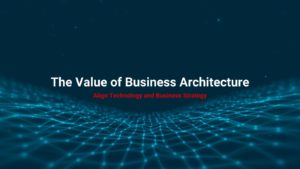Most company leaders are aligned on WHY they need to transform digitally. Some are aligned on WHAT “digital transformation” really means. But very few are aligned, across the company, on HOW to orchestrate and execute digital transformation.
If company leaders had any lingering hesitation about fully committing to the need for fundamental technology-enabled transformation, the COVID pandemic swiftly erased any remaining doubt. At this point, all companies should be clear about the compelling “WHY’s” of digital transformation – need for flexible supply chains, improved digital customer and employee experiences, bending the cost curve, tapping into new growth markets, among many others.
When it comes to aligning on WHAT that really means, the picture becomes more varied from company to company. To some leaders, “digital transformation” equates to a collection of technology initiatives like Cloud, AI, Blockchain, IoT and more. To others the meaning could center around reinventing the Customer Experience and whatever that entails. To yet others, the focus is a shift to agile practices, innovation teams and new and different ways of working. While all of these are important pieces of digital transformation, and seem straight forward, in reality the variety of “thought bubbles” over various leaders’ heads when the words “digital transformation” are spoken, can significantly hinder the odds of making a real impact.
The Feld Group Institute has always believed that an overarching, integrative and compelling shared vision of WHAT digital transformation should mean for the company, is a critical foundation that shouldn’t be overlooked. We think of it as recapturing the entrepreneurial sense-and-respond capability the organization had when it first began, both at the strategic and tactical levels, but now at speed and scale using technology. Everything is ultimately a means to that end.
But even if company leaders are aligned on the WHY and WHAT, transformation can still become frustrating (and expensive) if those leaders have differing mental models on HOW to orchestrate and execute. Often, it’s not easy to identify where this misalignment is happening. Establishing a common mental model or a shared framework for how big components of transformation relate to each other is the critical step toward getting aligned. A simple scan of the five interrelated models we use, could begin to identify where the weak links might be in your alignment:
Business Model: How does our business strategy translate into what business capabilities we need to build, buy, or transform in order to achieve our objectives?
The traditional strategy-cascading approach doesn’t work well in an increasingly cross-functional world. Often, functions or business units attempt to translate the corporate strategy into their own “digital” needs, which usually turns into a long list of IT projects. If instead, leaders can think in a common language of “business capabilities” first, they will be able to look across the needs of the various silos and recognize patterns, dependencies, and opportunities for leverage.
Technology Model: What is the best architecture of an enterprise-wide technology platform that gives us flexibility, speed, and leverage?
When strategy cascades directly into silo-level technology projects, the default often becomes “architecture” solely at a solution-level. A bigger, layered view of what the overall enterprise technology architecture is, and why it’s important to business objectives, should be understood and internalized by all leaders – both technical and non-technical.
Organization Model: What are the formal and informal organizational structures needed to reinforce the chosen Business and Technology Models?
The best formed Business and Technology Models, will still go nowhere if the company’s structures, culture, workforce composition, and leadership are not aligned to the bigger intentions.
Economic Model: How do we think about (and measure) technology investments, returns, and productivity?
If a leadership team’s mental model around IT economics consists solely of approving project-level ROIs and attempting to contain IT costs, chances are overall investment in technology will never come close to achieving the expected returns OR operating costs, and complexity of IT will frustratingly continue to rise. On the other hand, leaders who plan and justify technology funding in a “big” aperture, as a major operating platform of the company, as they would a fleet, a manufacturing platform, or a supply chain, have a much better chance of realizing returns on investment as well as continuous cost productivity of their technology landscape.
Operating Model: How do we Plan, Build, and Run our technology assets (i.e. how does our technology “factory” work)?
The effectiveness, reliability, and cost efficiency of how your technology “runs” is only as good as how well you “build” it. How well you build it is only as good as how well you “plan” it. If your technology planning is stuck in isolated project-level planning and constrained inside the typical annual budgeting exercises, then you will likely continue to deal with a fragmented technology platform that is not as reliable and cost efficient as it should be. If the Planning is integrated, layered, and in rolling waves, you will have both clarity of context, as well as flexibility to adjust along the way.
These models can be used to test alignment at any level of a company – across teams, across business units, or anywhere in between. A good first step for any leader to take is to start by looking at the adjacent “teams” around you (whether at the team, unit, function, or initiative level) and test “local” alignment across the above dimensions. But just achieving “local” alignment can have its limits. To really root out the weak links and achieve sustainable alignment, this ultimately needs to happen at the enterprise level.
If you find a weak link or lack of alignment on any one of the above, that piece will pull all the others out of alignment. If you see it in more than one or all five of these models, then chances are that a core group of leaders needs to first take a step back together, and get clearer alignment on the high-level story of WHY and WHAT. Then they can begin to align on the HOW of all five models.
Author: Kenny Feld, Principal, The Feld Group Institute
Connect With Kenny on LinkedIn
____________________________________________________________________________________________________
FURTHER LEARNING:
Many of these concepts are covered in depth in The Feld Group Institute’s Operationalizing Business Architecture class. If you’re interested in learning more about this important topic, additional resources can be found on this site, including: Aligning Business Value: We Need A Common Language , Aligning Strategy To Business Capabilities , Business Architecture – Linking Strategic Themes To Tactical Demand, Alignment Is Critical In Times Of Uncertainty, and in this short video with Charlie Feld Back To The Future Series – Alignment




